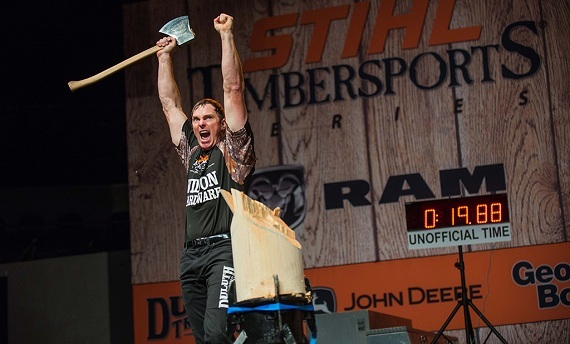Growing up, I remember watching ABC's Wide World of Sports. I loved when the less mainstream sports would be televised: surfing, skiing or lumberjack sports. I remember watching in amazement as the competitors challenged their abilities with insane feats of bravery.
The lumberjacks, to me, were the most foreign of athletes. They climbed the tree trunks at lightening speed, wheeled razor sharp axes to cut through logs, and ran massive chain saws. To give you some background on my perspective, let's just say that I wasn't raised in an environment that involved conquering the land and pushing my limits through bouts of bravery with forested mountains. I am the product of suburbia and very academic parents. I did, however, always have strong desires for adventure. I grew up on the coast, so my adventures were limited to water, sailing and waves. The forest and the mountains are something I have only recently come to know.
The weekend of June 20 to 22, I had the opportunity to witness the STIHL Timbersports U.S. Championships in person. More specifically, I was asked to participate in the event as a saw technician. The event was held in Norfolk, Virginia, STIHL USA's backyard. One of the largest manufacturing facilities for the STIHL Group is in Virginia Beach, so it was exciting for me to be able to invite friends to the event to see what I do for a living firsthand.
The event was held over three days. Friday was preliminary rounds for collegiate and professional athletes, followed by the U.S. Pro Championship on Saturday evening, and Collegiate Championship and relay events on Sunday. Each discipline is rooted in traditional tasks that lumberjacks have been competing in for over a century. These disciplines require athletic acumen and dexterity beyond most of our capabilities. I have been to many modern logging sites and let me tell you, you don't see lumberjacks springboarding spruce trees, or bucking tree trunks with a crosscut saw. So, it is interesting and inspiring to see these traditions carried on through sport.
My introduction to the sport started as a spectator Saturday night. Eight professional lumberjack athletes were vying for the U.S. title and a chance to represent the United States at the World Championships in Austria. I kept hearing the same name over and over -- Cogar. Two cousins, Matt Cogar and Arden Cogar, Jr., were dueling it out for the win. I learned later that a few families with the lumberjack gene have historically dominated this sport; names like Cogar, Lentz and Slingerland are common and only recently have faced newer challengers. This year's U.S. Pro Championship had eight up-and-coming competitors in the qualifying round, five of which made it to the finals. It appears to be the start of a new era in the sport.
A young Matt Cogar, for the second year running, won the event. He is considered a prodigy in the sport having only been a pro for three years. Adrian Flygt, STIHL Timbersport's announcer, believes Cogar has the talent and skill to pull off a couple more titles in a row. He is truly a dominant athlete.
Let's get back to the event. For me, the springboard and hot saw are hands down the most exciting disciplines. I don't think I need to explain the hot saw... or do I? (Hot saws are custom chainsaws that use a motorcycle or snowmobile engine for power.) First let me say these athletes are big guys, some comparable to NFL linemen. So when you see them holding the saw with all their might, and you hear the roar of that 150cc engine, you are sucked right into the intensity of the moment. The saws are started and are warmed up. Fans cover their ears because the sound of the exhaust is ringing their ear drums. You can literally feel the power of the saws. The heats only last six seconds or so, but... it's a powerful six seconds.
Next is the springboard. This discipline was used by loggers on steep mountains to chop down trees before the common use of chainsaws. The competitors have to chop slots into a tree trunk, insert a board, then hop on the board to chop another slot, inserting another board and ending by performing a block chop at the top of the tree. For the competitors, I don't know what it must feel like. To me, it looks fun. It mixes pretty much every athletic skill there is. For the fans, there's anxiety witnessing powerful athletes perform complicated movements at blistering speeds, hoping that no one falls.
I need to also clarify here that this is a sport. A competition of athletic ability designed to showcase individuals' abilities as lumberjacks. Being a lumberjack is one of the most dangerous jobs in the world. People die and get seriously hurt performing regular, everyday job functions, which in today's world does not involve springboarding, block-chopping or cross-cutting. These athletes are high-speed lumberjacks, performing disciplines that involve a high level of focus and ability to ensure not only a win, but that all of their extremities are intact when all is said and done. THIS IS A SPORT!
Sunday, I had the opportunity to work the event as a saw technician, which means I was responsible for helping make sure that the two competition saws were equally tuned and running at the highest possible RPMs before being presented to the athletes for the events. During the competitions, I watched for safety aspects and to ensure all personal protective equipment was correctly in place, that the athlete correctly operated the saw, and, in the case of a malfunction, determined the fault.
I had a great time as a spectator the day before, but I was unaware of the effort involved with pulling this event off. Just the amount of wood needed for all the different disciplines is amazing. I had a chance to speak with Don Quigley, the STIHL Timbersports "wood boss," about the procurement of the wood. He said that the wood boss' job is to reduce the variation in environmental factors that impact the tree. Simply put, the trees must come from the same place, with the same sun exposure, water, wind and temperatures. White pine is always used as it is easy to see its knots and it holds moisture well; both attributes of the wood that impact competitors approach in the different disciplines. Don was adamant that competitors can be assured that each piece of wood used for a particular event came from the same tree. This reduces inconsistency in the wood, which in turn affects the competitors' ability to perform the discipline.
This year's wood came from an undisclosed location in Ohio. As Don said, "A good stand of wood is kind of like finding a good fishing hole. You don't want people to know where it is."
The wood was harvested as part of an effort to rid this part of Ohio of white pine, which is not indigenous to the area. The pine was planted in the 1950s as part of a watershed management project. And it was recently decided that the pines should be harvested to make room for the natural hardwood forest to regenerate. After the wood is harvested it is sent to Don's in New Hampshire where it is lathed and prepped for transport to the event. All the wood is prepared in different lengths depending on the discipline it is being used for. The competitors then draw numbers at random to pick the wood they are going to be working.
The wood is only one part of the event. You have to move the wood on and off the deck and ensure the saws are running well. There are announcers, TV cameras, photographers, and fans. Everything happens at an insane pace and with a heightened level of efficiency. I worked during the Collegiate Championship and the relay event. It was great to learn that most of the college athletes are obtaining degrees in fields related to forestry. Our need to maintain our vast forests and manage them for generations is even more prevalent today. And knowing that the athletes are connected to the sport on a personal level makes it all the more inspiring.
The relays were really fun. For us it was two hours of focusing on the stock saws and making sure they were doing a good job for the athletes. Everyone is working hard to get the heats going quickly. Then, watching all the different disciplines at once gives fans a great look at the sport. I was very impressed and had to pinch myself, thinking, "Wow, I'm really here, on ABC!" What an adventure!



